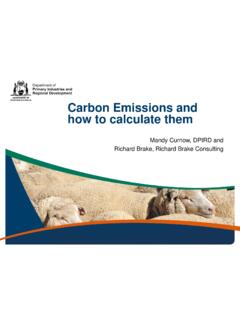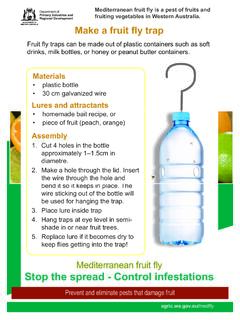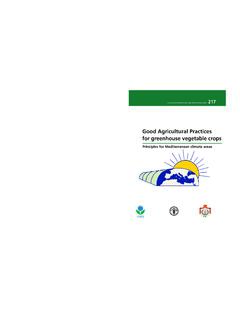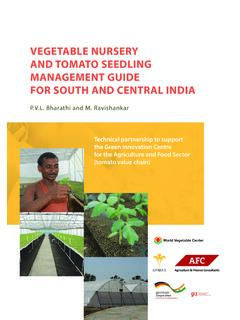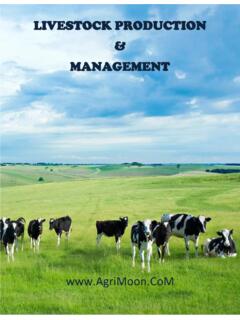Transcription of The Horticulture Handbook - agric.wa.gov.au
1 The Horticulture handbookA reference guide for establishing Horticulture enterprises in Western AustraliaSupporting your successBulletin 4847 ISSN 1833-7236 Department ofAgriculture and FoodDISCLAIMERThe Chief Executive Officer of the Department of Agriculture and Food and the State of Western Australia accept no liability whatsoever by reason of negligence or otherwise arising from the use or the release of this information or any part of Baron-Hay Court South Perth WA 6151 Tel: +61 (0)8 9368 3333 Email: Western Australian Agriculture Authority, 2014 The Horticulture handbookA reference guide for establishing Horticulture enterprises in Western AustraliaBulletin 4847 ISSN 1833-7236 April 20143 HOME32 ContentsIntroduction.
2 3 Acknowledgements ..3 Horticulture checklist ..4 Part A: Regulations and licences ..4 Part B: Crop requirements ..8 Part C: Budgets and marketing ..11 Horticulture for fun, profit or ruin? ..151. The major issue: water availability ..152. Key issues: water, market, climate, labour and soils ..153. Other important issues ..254. Growing for profit ..285. Comments on selected crops ..306. Tax matters ..39 Guide to legislation ..40 Overview ..401. Planning controls ..412. Land clearing controls ..443. Pollution controls ..464. Drainage and pumping controls ..495.
3 Water licences ..526. Fire control measures ..537. Property access/egress controls.. 548. Flora/fauna controls ..559. Handling and applying chemicals ..56 References ..59 Contact details ..603 HOME3 IntroductionThe Department of Agriculture and Food, Western Australia (DAFWA) assists WA s $6 billion agriculture and food sector to be sustainable and profitable, with a clear focus on export-led growth. Our department s vision is: a progressive, innovative and profitable agriculture and food sector that benefits Western Australia . Our role as an economic development department is about supporting the success of, and creating value for, businesses all along the supply chain.
4 The Horticulture Handbook has been developed by the DAFWA Small Landholder Information Service (SLIS). This Handbook is designed to acquaint landholders and potential investors with the regulations, requirements and considerations necessary to develop a block of land for Horticulture in WA. High prices, climate suitability and identified market opportunities make some horticultural crops appear an attractive investment. Before deciding to invest it is important to research a crop thoroughly from production planning all the way to the consumer. Thorough investigation will reveal a crop s true potential and help you make the best Horticulture Handbook is a valuable guide, which includes a checklist and sections on regulations, key issues, production and marketing costs and approvals, along with a list of references and useful Handbook is an excellent source of information designed to assist you to successfully establish a new horticultural business in Guise Regional Director, South West Agricultural RegionApril.
5 2014 AcknowledgementsThis publication would not have been possible without the cooperation of officers from across the Western Australian government departments and thanks to staff from the Department of Agriculture and Food, Department of Environment Regulation, Department of Health, Department of Planning and Department of Water for the original content. Reviewed and updated by Jodie Bowling, Martine Combret, James Dee, Farran Dixon, Richard Fennessy, Alec McCarthy, Heather Percy, Rohan Prince, Helen Newman, Peter Tille, Leon van Wyk and Andrew Watson, Department of Agriculture and Food Western Australia.
6 Also reviewed and updated by the Department of Environment Regulation and Main Roads Western checklist54 HOMEH orticulture checklist This checklist is designed to get you thinking about some of the important things to consider before embarking on a horticultural considering questions and cross checking actions, potential investors can increase the likely success and profitability of their new business. Detailed information, tips and pointers are included to help potential investors answer the questions within the are two ways to approach investment in Horticulture .
7 One is to identify market opportunities before considering the purchase of suitable land. The other approach is to identify opportunities to utilise an existing area of land. This checklist starts with the assumption that you own, or have your eye on, a particular parcel of checklist is presented in three parts:Part A: Regulations that apply to the use of land and licences you may need to develop a block for B: Crop requirements suitability of local climatic conditions, soil type and water C: production and marketing costs and the boxes beside each action to keep track of what you have and have not considered.
8 Part A: Regulations and licencesAre there any local, regional or state planning regulations concerning horticultural activities on the proposed development site?To avoid conflict between different land uses and to support horticultural development in priority areas, there may be regulations in place that restrict or promote horticultural activity on the site. Certain developments or changes in land use listed under local or regional planning schemes will require approval. Failure to obtain approval where necessary is an offence. Action: Read Guide to legislation, section 1 (see page 41).
9 Check with your local government authority (LGA) for possible controls on horticultural developments, including minimum setback regulations, bans on the use of particular chemicals and bans on the use of manures. Ask your LGA planning department if there are any other regional or state planning policies or schemes concerning horticultural activity on the site. Horticulture checklist5 Horticulture checklistHOMEH orticulture checklistDo you need to clear land?Permits from the Department of Environment Regulation (DER) and potentially your LGA are required to clear land.
10 It is important to investigate the legalities and environmental impact of any land clearing before planning further development. Information on land clearing, including application forms, fact sheets and guides can be found on the DER website. In reviewing proposals, the principles contained in Schedule 5 of the Environmental Protection Act 1986 (EP Act) and also any planning instrument or other relevant matter are considered. The clearing principles consider environmental impacts on biodiversity values, water quality and land degradation. Clearing that significantly impacts on the environment is generally not supported.
